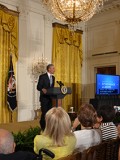
Aging study looks at health, socioeconomic trends
“An Aging World: 2015” was commissioned by the National Institute on Aging (NIA), part of the National Institutes of Health, and produced by the U.S. Census Bureau. The report on aging examines the demographic, health and socioeconomic trends accompanying the growth of the aging population.
“Older people are a rapidly growing proportion of the world’s population,” said NIA Director Richard J. Hodes, M.D. “People are living longer, but that does not necessarily mean that they are living healthier. The increase in our aging population presents many opportunities and also several public health challenges that we need to prepare for. NIA has partnered with Census to provide the best possible data so that we can better understand the course and implications of population aging.”
Study focuses on life expectancy, health, systems and more
“An Aging World: 2015” contains detailed information about life expectancy, gender balance, health, mortality, disability, health care systems, labor force participation and retirement, pensions and poverty among older people around the world.
“We are seeing population aging in every country in every part of the world,” said John Haaga, Ph.D., acting director of NIA’s Division of Behavioral and Social Research. “Many countries in Europe and Asia are further along in the process, or moving more rapidly, than we are in the United States. Since population aging affects so many aspects of public life—acute and long-term health care needs; pensions, work and retirement; transportation; housing—there is a lot of potential for learning from each other’s experience.”
Report highlights
• America’s 65-and-over population is projected to nearly double over the next three decades, from 48 million to 88 million by 2050.
• By 2050, global life expectancy at birth is projected to increase by almost eight years, climbing from 68.6 years in 2015 to 76.2 years in 2050.
• The global population of the “oldest old”—people aged 80 and older—is expected to more than triple between 2015 and 2050, growing from 126.5 million to 446.6 million. The oldest old population in some Asian and Latin American countries is predicted to quadruple by 2050.
• Among the older population worldwide, noncommunicable diseases are the main health concern. In low-income countries, many in Africa, the older population faces a considerable burden from both noncommunicable and communicable diseases.
• Risk factors—such as tobacco and alcohol use, insufficient consumption of vegetables and fruit, and low levels of physical activity—directly or indirectly contribute to the global burden of disease. Changes in risk factors have been observed, such as a decline in tobacco use in some high-income countries, with the majority of smokers worldwide now living in low- and middle-income countries.
Sportpoint/Shutterstock photo












